1. Chen TK, Knicely DH, Grams ME. Chronic kidney disease diagnosis and management: a review. JAMA. 2019; 322:1294–1304. PMID:
31573641.
2. Bryer JS, Susztak K. Screening drugs for kidney disease: targeting the podocyte. Cell Chem Biol. 2018; 25:126–127. PMID:
29452609.
3. Akyüz Özdemir A, Erdal R, Haberal M. Factors predisposing to the use of complementary therapies in patients with chronic renal failure. Exp Clin Transplant. 2018; 16(Suppl 1):64–69. PMID:
29527995.
4. Tagawa A, Yasuda M, Kume S, Yamahara K, Nakazawa J, Chin-Kanasaki M, Araki H, Araki S, Koya D, Asanuma K, et al. Impaired podocyte autophagy exacerbates proteinuria in diabetic nephropathy. Diabetes. 2016; 65:755–767. PMID:
26384385.
5. Guo H, Bechtel-Walz W. The interplay of autophagy and oxidative stress in the kidney: what do we know? Nephron. 2023; 147:627–642. PMID:
37442108.
6. Xue L, Pan Z, Yin Q, Zhang P, Zhang J, Qi W. Liraglutide promotes autophagy by regulating the AMPK/mTOR pathway in a rat remnant kidney model of chronic renal failure. Int Urol Nephrol. 2019; 51:2305–2313. PMID:
31531806.
7. Li YY, Tian ZH, Pan GH, Zhao P, Pan DJ, Zhang JQ, Ye LY, Zhang FR, Xu XD. Heidihuangwan alleviates renal fibrosis in rats with 5/6 nephrectomy by inhibiting autophagy. Front Pharmacol. 2022; 13:977284. PMID:
36160409.
8. Wang Y, Feng Y, Li M, Yang M, Shi G, Xuan Z, Yin D, Xu F. Traditional Chinese medicine in the treatment of chronic kidney diseases: theories, applications, and mechanisms. Front Pharmacol. 2022; 13:917975. PMID:
35924053.
9. Yoshino T, Horiba Y, Mimura M, Watanabe K. Oral
Astragalus root supplementation for mild to moderate chronic kidney disease: a self-controlled case-series. Front Pharmacol. 2022; 13:775798. PMID:
35300298.
10. Sun X, Li P, Lin H, Ni Z, Zhan Y, Cai G, Liu C, Chen Q, Wang W, Wang X, et al. Efficacy and safety of
Abelmoschus manihot in treating chronic kidney diseases: a multicentre, open-label and single-arm clinical trial. Phytomedicine. 2022; 99:154011. PMID:
35278897.
11. Li J, Ke T, He C, Cao W, Wei M, Zhang L, Zhang JX, Wang W, Ma J, Wang ZR, et al. The anti-arthritic effects of synthetic melittin on the complete Freund’s adjuvant-induced rheumatoid arthritis model in rats. Am J Chin Med. 2010; 38:1039–1049. PMID:
21061459.
12. An HJ, Kim JY, Kim WH, Han SM, Park KK. The protective effect of melittin on renal fibrosis in an animal model of unilateral ureteral obstruction. Molecules. 2016; 21:1137. PMID:
27618890.
13. Kim JY, Leem J, Hong HL. Melittin ameliorates endotoxin-induced acute kidney injury by inhibiting inflammation, oxidative stress, and cell death in mice. Oxid Med Cell Longev. 2021; 2021:8843051. PMID:
33488946.
14. He SD, Tan N, Sun CX, Liao KH, Zhu HJ, Luo XG, Zhang JY, Li DY, Huang SG. Treatment with melittin induces apoptosis and autophagy of Fibroblast-Like Synoviocytes in patients with rheumatoid arthritis. Curr Pharm Biotechnol. 2020; 21:734–740. PMID:
31820689.
15. Memariani H, Memariani M. Melittin as a promising anti-protozoan peptide: current knowledge and future prospects. AMB Express. 2021; 11:69. PMID:
33983454.
16. Aghighi Z, Ghorbani Z, Moghaddam MH, Fathi M, Abdollahifar MA, Soleimani M, Karimzadeh F, Rasoolijazi H, Aliaghaei A. Melittin ameliorates motor function and prevents autophagy-induced cell death and astrogliosis in rat models of cerebellar ataxia induced by 3-acetylpyridine. Neuropeptides. 2022; 96:102295. PMID:
36280441.
17. Sun Q, Chen W, Wang M, Zheng P, Gao M, Song F, Li CA. “Chase and Block” strategy for enhanced cancer therapy with hypoxia-promoted photodynamic therapy and autophagy inhibition based on upconversion nanocomposites. Adv Healthc Mater. 2023; 12:e2301087. PMID:
37248635.
18. Yang RC, Zhu XL, Wang J, Wan F, Zhang HQ, Lin Y, Tang XL, Zhu B. Bone marrow mesenchymal stem cells attenuate the progression of focal segmental glomerulosclerosis in rat models. BMC Nephrol. 2018; 19:335. PMID:
30466397.
19. Ware K, Brodsky P, Satoskar AA, Nadasdy T, Nadasdy G, Wu H, Rovin BH, Bhatt U, Von Visger J, Hebert LA, et al. Warfarin-related nephropathy modeled by nephron reduction and excessive anticoagulation. J Am Soc Nephrol. 2011; 22:1856–1862. PMID:
21885669.
20. Yang L, He X, Zhi D, Xue Y, Gong X, Dong K, Tian Y. Melittin promotes dexamethasone in the treatment of adjuvant rheumatoid arthritis in rats. Front Pharmacol. 2024; 15:1338432. PMID:
38414737.
21. Naji KM, Al-Khatib BY, Al-Haj NS, D’souza MR. Hepatoprotective activity of melittin on isoniazid- and rifampicin-induced liver injuries in male albino rats. BMC Pharmacol Toxicol. 2021; 22:39. PMID:
34217369.
22. Duan X, Chen C, Liu X, Wang T, Feng S, Li J, Li G. Interference of periostin attenuates pathological changes, proinflammatory markers and renal fibrosis in diabetic kidney injury. Genes Genomics. 2023; 45:1389–1397. PMID:
37248423.
23. Ji J, He L. Effect of Kangxianling decoction on expression of TGF-
β1/Smads and extracellular matrix deposition. Evid Based Complement Alternat Med. 2019; 2019:5813549. PMID:
30713574.
24. Zhang Z, Zhang Y, Ning G, Deb DK, Kong J, Li YC. Combination therapy with AT1 blocker and vitamin D analog markedly ameliorates diabetic nephropathy: blockade of compensatory renin increase. Proc Natl Acad Sci U S A. 2008; 105:15896–15901. PMID:
18838678.
25. Moon DO, Park SY, Lee KJ, Heo MS, Kim KC, Kim MO, Lee JD, Choi YH, Kim GY. Bee venom and melittin reduce proinflammatory mediators in lipopolysaccharide-stimulated BV2 microglia. Int Immunopharmacol. 2007; 7:1092–1101. PMID:
17570326.
26. Du YR, Xiao Y, Lu ZM, Ding J, Xie F, Fu H, Wang Y, Strong JA, Zhang JM, Chen J. Melittin activates TRPV1 receptors in primary nociceptive sensory neurons via the phospholipase A2 cascade pathways. Biochem Biophys Res Commun. 2011; 408:32–37. PMID:
21453681.
27. Ding J, Xiao Y, Lu D, Du YR, Cui XY, Chen J. Effects of SKF-96365, a TRPC inhibitor, on melittin-induced inward current and intracellular Ca2+ rise in primary sensory cells. Neurosci Bull. 2011; 27:135–142. PMID:
21614096.
28. Fukuyo Y, Nakamura T, Bubenshchikova E, Powell R, Tsuji T, Janknecht R, Obara T. Nephrin and Podocin functions are highly conserved between the zebrafish pronephros and mammalian metanephros. Mol Med Rep. 2014; 9:457–465. PMID:
24337247.
29. Menon MB, Dhamija S. Beclin 1 phosphorylation - at the center of autophagy regulation. Front Cell Dev Biol. 2018; 6:137. PMID:
30370269.
30. Tanida I, Ueno T, Kominami E. LC3 and autophagy. Methods Mol Biol. 2008; 445:77–88. PMID:
18425443.
31. Kim YC, Guan KL. mTOR: a pharmacologic target for autophagy regulation. J Clin Invest. 2015; 125:25–32. PMID:
25654547.
32. Breyer MD, Susztak K. The next generation of therapeutics for chronic kidney disease. Nat Rev Drug Discov. 2016; 15:568–588. PMID:
27230798.
33. Lee HW, Khan SQ, Faridi MH, Wei C, Tardi NJ, Altintas MM, Elshabrawy HA, Mangos S, Quick KL, Sever S, et al. A podocyte-based automated screening assay identifies protective small molecules. J Am Soc Nephrol. 2015; 26:2741–2752. PMID:
25858967.
34. Lin Q, Banu K, Ni Z, Leventhal JS, Menon MC. Podocyte autophagy in homeostasis and disease. J Clin Med. 2021; 10:1184. PMID:
33809036.
35. Mizushima N, Yamamoto A, Matsui M, Yoshimori T, Ohsumi Y.
In vivo analysis of autophagy in response to nutrient starvation using transgenic mice expressing a fluorescent autophagosome marker. Mol Biol Cell. 2004; 15:1101–1111. PMID:
14699058.
36. Leventhal JS, Wyatt CM, Ross MJ. Recycling to discover something new: the role of autophagy in kidney disease. Kidney Int. 2017; 91:4–6. PMID:
28003091.
37. Li H, Peng X, Wang Y, Cao S, Xiong L, Fan J, Wang Y, Zhuang S, Yu X, Mao H. Atg5-mediated autophagy deficiency in proximal tubules promotes cell cycle G2/M arrest and renal fibrosis. Autophagy. 2016; 12:1472–1486. PMID:
27304991.
38. Andrade L, Rodrigues CE, Gomes SA, Noronha IL. Acute kidney injury as a condition of renal senescence. Cell Transplant. 2018; 27:739–753. PMID:
29701108.
39. Choi M, Ryu J, Vu HD, Kim D, Youn YJ, Park MH, Huynh PT, Hwang GB, Youn SW, Jeong YH. Transferrin-conjugated melittin-loaded l-arginine-coated iron oxide nanoparticles for mitigating beta-amyloid pathology of the 5XFAD mouse brain. Int J Mol Sci. 2023; 24:14954. PMID:
37834402.
40. Karimi G, Fatemi S, Memar B, Khorrami MB, Amali A, Sadeghi M, Esmaeili SA, Riahi-Zanjani B. Melittin as a safe compound to BALB/c mice immune system; a tiered approach immunotoxicity screening. BMC Complement Med Ther. 2023; 23:377. PMID:
37880739.
41. Lv C, Zhang Z, Zhao T, Han MF, Jia DP, Su LZ, Huang F, Wang FZ, Fang FF, Li B. The anti-tumour effect of Mel and its role in autophagy in human hepatocellular carcinoma cells. Am J Transl Res. 2019; 11:931–941. PMID:
30899392.
42. Yu JE, Kim Y, Hong DE, Lee DW, Chang JY, Yoo SS, Kim MJ, Son DJ, Yun J, Han SB, et al. Bee venom triggers autophagy-induced apoptosis in human lung cancer cells via the mTOR signaling pathway. J Oncol. 2022; 2022:8916464. PMID:
36590307.
43. Lv C, Chen J, Huang F, Fang F, Li B. Melittin inhibits the proliferation migration and invasion of HCC cells by regulating ADAMTS9-AS2 demethylation. Toxicon. 2023; 222:106996. PMID:
36535531.
44. Lim HN, Baek SB, Jung HJ. Bee venom and its peptide component melittin suppress growth and migration of melanoma cells via inhibition of PI3K/AKT/mTOR and MAPK pathways. Molecules. 2019; 24:929. PMID:
30866426.
45. Jeong YJ, Choi Y, Shin JM, Cho HJ, Kang JH, Park KK, Choe JY, Bae YS, Han SM, Kim CH, et al. Melittin suppresses EGF-induced cell motility and invasion by inhibiting PI3K/Akt/mTOR signaling pathway in breast cancer cells. Food Chem Toxicol. 2014; 68:218–225. PMID:
24675423.
46. Fan XG, Pei SY, Zhou D, Zhou PC, Huang Y, Hu XW, Li T, Wang Y, Huang ZB, Li N. Melittin ameliorates inflammation in mouse acute liver failure via inhibition of PKM2-mediated Warburg effect. Acta Pharmacol Sin. 2021; 42:1256–1266. PMID:
32939034.
47. Gu H, An HJ, Gwon MG, Bae S, Leem J, Lee SJ, Han SM, Zouboulis CC, Park KK. Bee venom and its major component melittin attenuated
Cutibacterium acnes- and IGF-1-induced acne vulgaris via inactivation of Akt/mTOR/SREBP signaling pathway. Int J Mol Sci. 2022; 23:3152. PMID:
35328573.
48. Moreira Castro BF, Nunes da Silva C, Barbosa Cordeiro LP, Pereira de Freitas Cenachi S, Vasconcelos-Santos DV, Machado RR, Dias Heneine LG, Silva LM, Silva-Cunha A, Fialho SL. Low-dose melittin is safe for intravitreal administration and ameliorates inflammation in an experimental model of uveitis. Curr Res Pharmacol Drug Discov. 2022; 3:100107. PMID:
35647524.
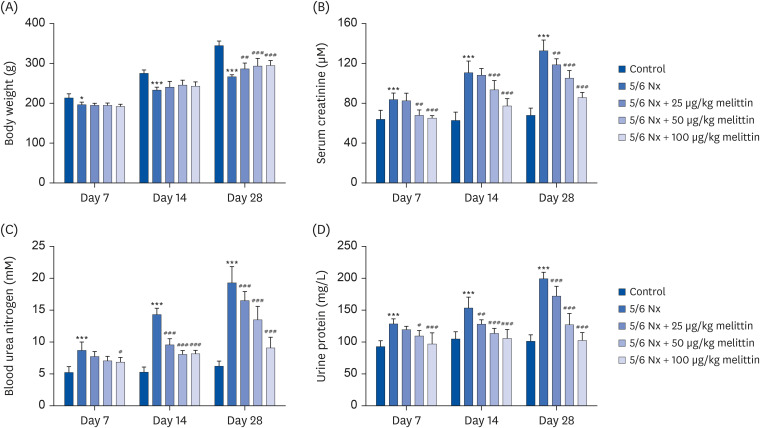
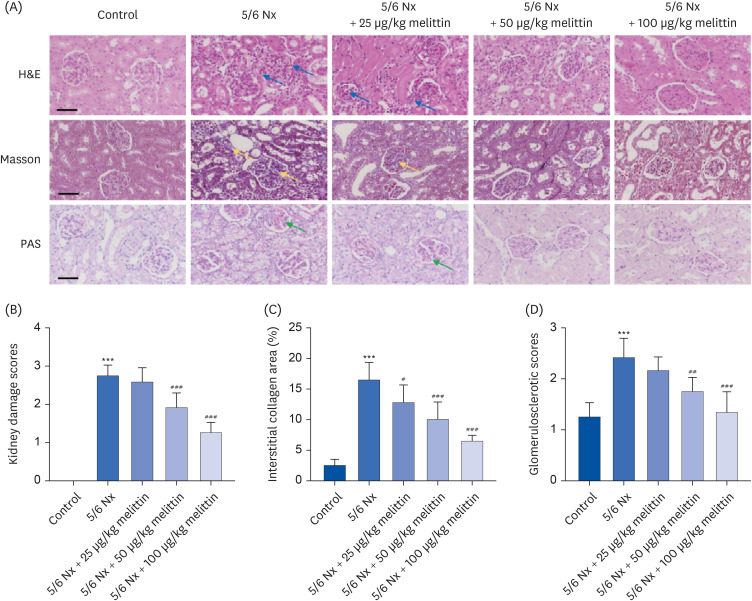
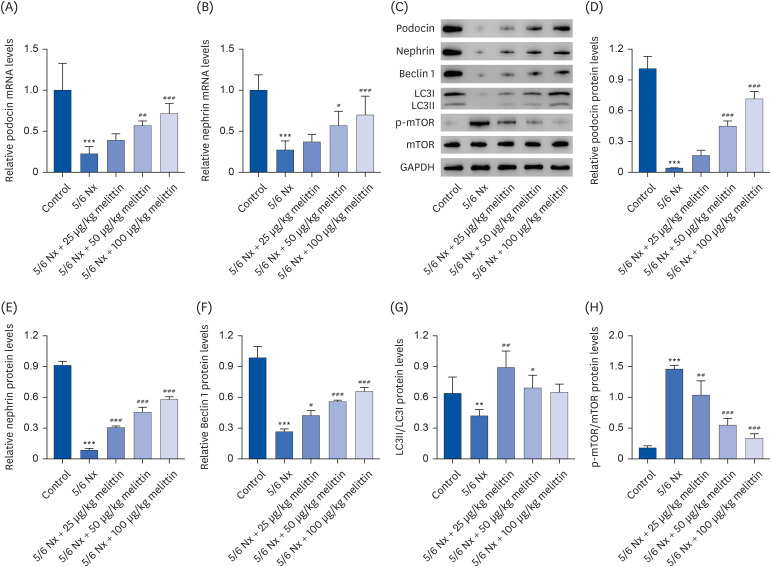
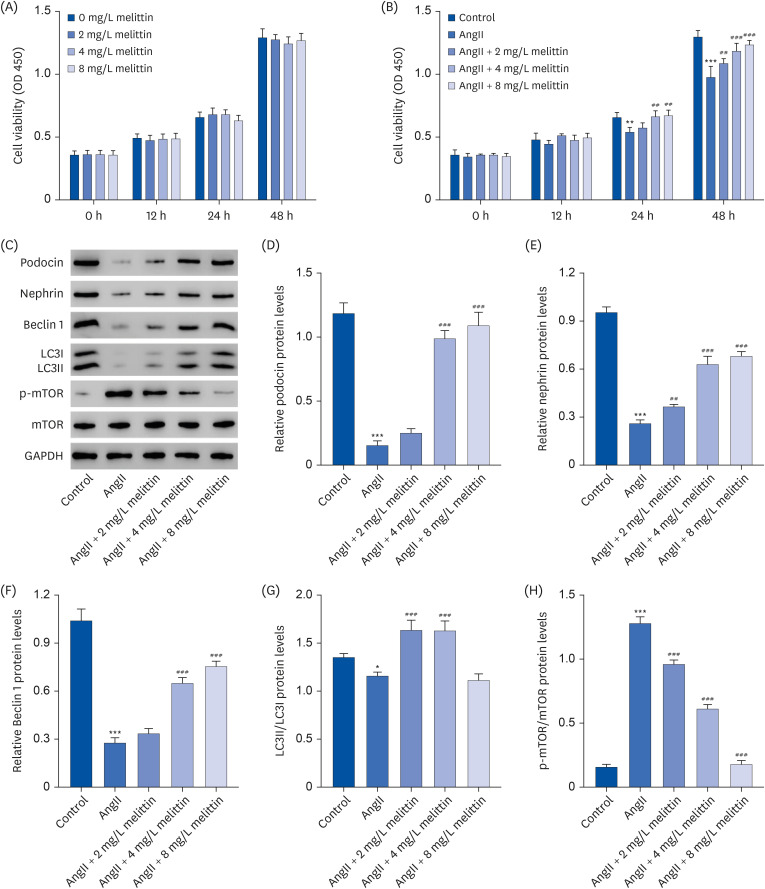
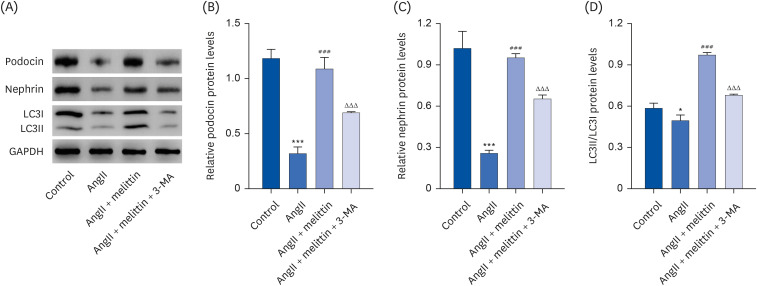




 PDF
PDF Citation
Citation Print
Print



 XML Download
XML Download